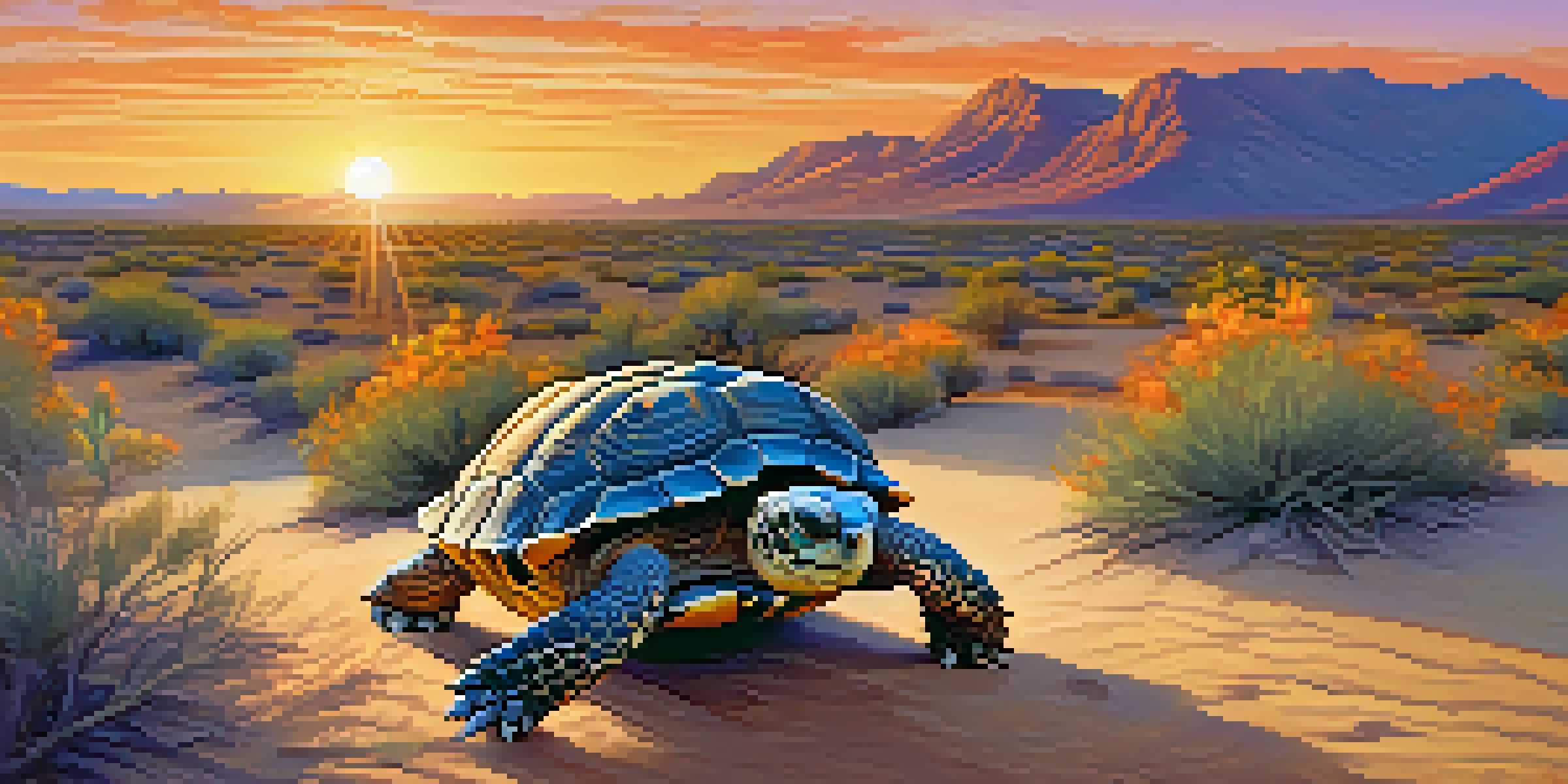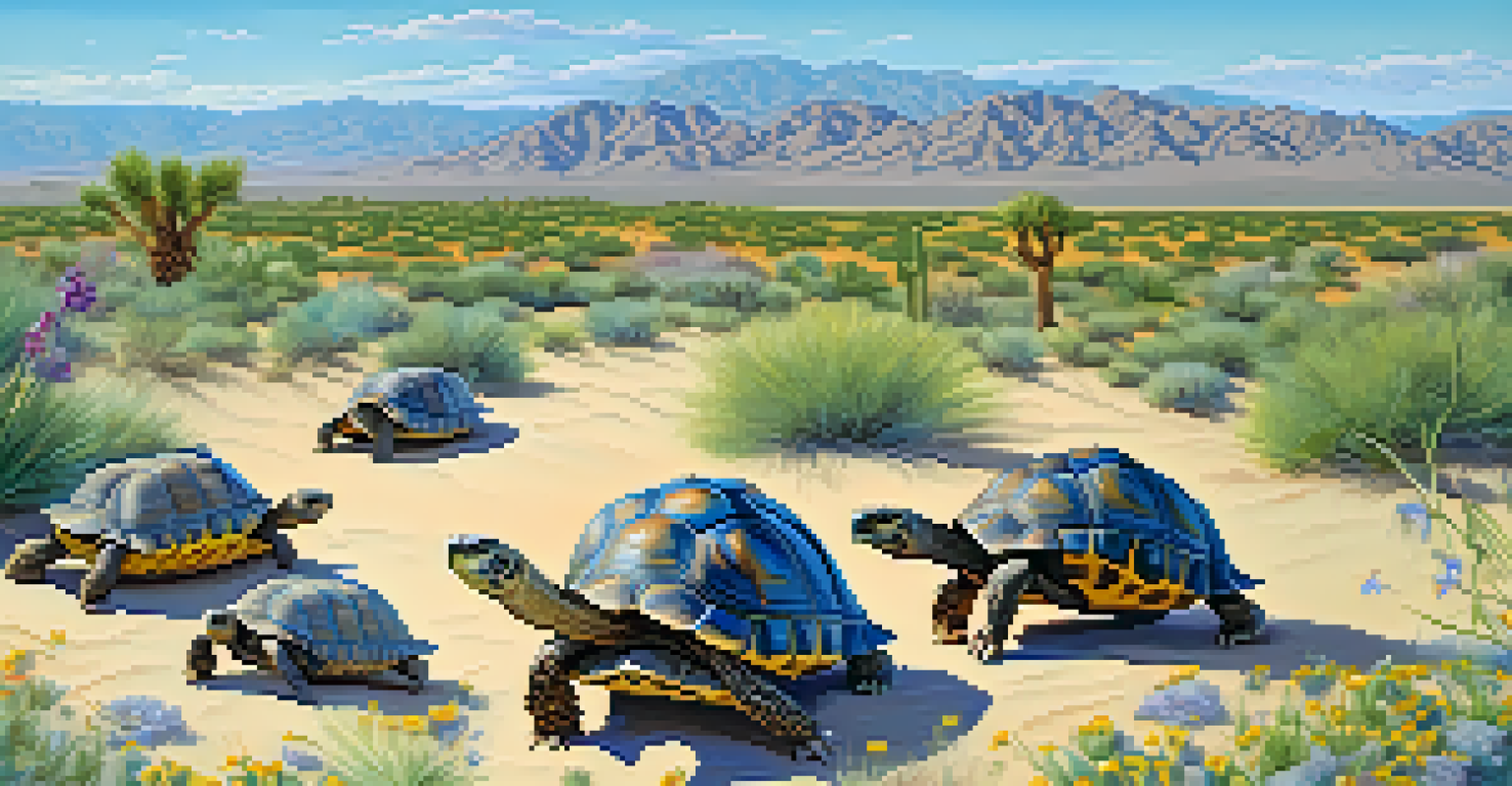Meet the Desert Tortoise: An Icon of Palm Springs Wildlife

Introduction to the Desert Tortoise: A Local Icon
The desert tortoise is more than just a creature of the arid landscape; it’s a symbol of the rich biodiversity found in Palm Springs. Known for its distinctive domed shell and slow-moving nature, this reptile has become an emblem of resilience in the harsh desert environment. As an endangered species, the desert tortoise captures the attention of conservationists and nature lovers alike, making it an important part of the local ecosystem.
In every walk with nature one receives far more than he seeks.
Living in the desert, these tortoises have adapted to survive in a climate where others might struggle. They can go for long periods without water, relying on moisture from the plants they eat. This remarkable ability to thrive in extreme conditions highlights their unique place in the natural world, reminding us of the incredible adaptations that wildlife undergoes to survive.
In this article, we’ll explore the life, habitat, and conservation efforts surrounding the desert tortoise, shedding light on why this remarkable creature deserves our attention and protection.
Habitat and Distribution of the Desert Tortoise
The desert tortoise primarily inhabits the Mojave and Sonoran deserts, with Palm Springs being a key area for their population. They prefer sandy, well-drained soil where they can dig burrows to escape the extreme desert heat. These burrows serve as both shelters and places for nesting, highlighting the tortoise's reliance on the unique aspects of its environment.

In Palm Springs, you might find these tortoises in areas like the Coachella Valley Desert Preserve, where their natural habitat remains relatively undisturbed. The landscape is dotted with creosote bushes and cacti, which provide essential food sources. Understanding their habitat helps us appreciate the delicate balance of life in the desert and the importance of preserving these spaces.
Desert Tortoise: A Local Icon
The desert tortoise symbolizes the rich biodiversity of Palm Springs and highlights the importance of conservation efforts.
Unfortunately, urban development and habitat destruction pose significant threats to their existence. Efforts to protect and restore these habitats are crucial to ensuring that the desert tortoise can continue to thrive in Palm Springs.
Diet and Feeding Habits of the Desert Tortoise
Desert tortoises are herbivores, primarily munching on a diet of grasses, wildflowers, and desert plants. They play a vital role in their ecosystem by helping to disperse seeds and maintain the health of their habitat. By grazing on various plants, they contribute to the balance of the desert flora, demonstrating the interconnectedness of life.
The clearest way into the Universe is through a forest wilderness.
These tortoises are also known for their unique feeding behavior, which involves using their strong jaws to chew through tough vegetation. You may often see them foraging during the cooler parts of the day, especially in the spring when food is abundant. Their diet may vary with the seasons, showcasing their ability to adapt to the ever-changing desert environment.
Understanding their diet not only highlights the tortoise's role in the ecosystem but also emphasizes the importance of preserving native plant species. Without a healthy plant community, the tortoise's survival could be jeopardized.
Reproduction and Lifecycle of the Desert Tortoise
The reproductive cycle of the desert tortoise begins with courtship, which can involve elaborate displays and vocalizations. After mating, the female will lay eggs in a burrow, usually around June. The eggs are left to incubate in the warm desert sands, typically hatching between 90 to 120 days later, although the exact timing can vary based on environmental conditions.
Once hatched, baby tortoises are on their own, facing numerous challenges as they navigate the desert landscape. They are vulnerable to predators and must quickly learn to find food and shelter. This stage of life is crucial, as many young tortoises do not survive their first year due to the harsh conditions they face.
Habitat Loss Threatens Survival
Urbanization and climate change are major threats to the desert tortoise, leading to habitat destruction and population decline.
The desert tortoise can live for 50 years or more in the wild, which makes their slow reproductive rate a significant factor in their population decline. This long lifespan highlights the importance of protecting their habitats to ensure that future generations can thrive.
Threats to the Desert Tortoise Population
Despite their resilience, desert tortoises face numerous threats that have led to their classification as a threatened species. One of the primary risks is habitat loss due to urbanization and development. As cities expand, the natural environments that support these tortoises are often destroyed or fragmented, making it difficult for them to find food and mates.
In addition to habitat destruction, the impact of climate change poses a significant threat. Rising temperatures and altered rainfall patterns can affect the availability of food and water, putting additional stress on tortoise populations. Moreover, wildfires and invasive species further compound these challenges, creating an uncertain future for these creatures.
Conservation efforts are critical to mitigating these threats. By raising awareness and advocating for habitat protection, we can help ensure that the desert tortoise continues to be a thriving part of the Palm Springs ecosystem.
Conservation Efforts for the Desert Tortoise
Various organizations and government agencies have launched initiatives to conserve desert tortoise populations and their habitats. These efforts include habitat restoration projects, public awareness campaigns, and research initiatives aimed at better understanding tortoise behavior and ecology. Through collaboration, stakeholders work together to create strategies that support both the tortoise and the broader desert ecosystem.
One effective approach is the establishment of protected areas where tortoises can thrive without the pressures of urban development. The Coachella Valley Desert Preserve is one such area, offering a sanctuary for these reptiles and allowing them to flourish in their natural habitat. Such protected spaces are crucial for their survival, providing safe environments for breeding and foraging.
Community Involvement is Key
Local residents can make a significant impact on desert tortoise conservation through education, volunteering, and responsible recreation.
Community involvement plays a vital role in these conservation efforts. Educating local residents about the importance of the desert tortoise and encouraging sustainable practices can make a significant difference in protecting these remarkable creatures for generations to come.
How You Can Help the Desert Tortoise
If you're passionate about wildlife and want to contribute to the conservation of the desert tortoise, there are several ways you can help. One of the simplest actions is to educate yourself and others about the challenges these tortoises face. Sharing information through social media or community events can raise awareness and inspire others to take action.
Volunteering with local conservation organizations is another impactful way to support desert tortoise preservation efforts. Many groups engage in habitat restoration projects, educational programs, and monitoring tortoise populations. Your time and effort can make a tangible difference in protecting these iconic creatures and their habitats.

Lastly, practicing responsible recreation in the desert is crucial. Staying on marked trails, avoiding disturbing wildlife, and following regulations can help minimize your impact on tortoise habitats. Every small action contributes to the larger goal of ensuring that the desert tortoise remains a thriving symbol of Palm Springs wildlife.